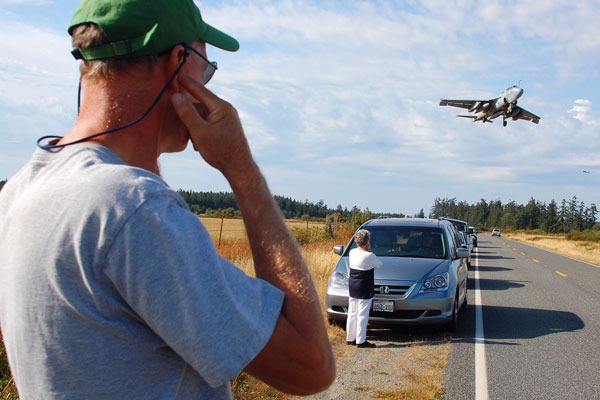A Coupeville-based citizens’ group, which sued the Navy in federal court in July, has begun the process of putting its lawsuit on hold while accusing the Navy of “backpedaling.”
The group sued the Navy in July over jet noise at Outlying Field Coupeville or OLF, part of Whidbey Island Naval Air Station, and demanded an Environmental Impact Statement or EIS from the Navy. The Navy suspended operations at OLF until the end of the year and announced this month its intention to initiate an EIS.
David Mann, lawyer for the Coupeville-based Citizens of Ebeys Reserve, said he was approached by the Navy last week, asking if the lawsuit was “moot” now that the EIS had begun. Mann said the group remains hesitant to dismiss the
lawsuit because the scope of the EIS will not be determined for several months. Still, Mann said they plan to put the suit on hold in the meantime.
“If we can reach an agreement and get a judge to agree to it, we’ll put it on hold until we see the complete document,” Mann said.
Still, group members have voiced some concern that the scope of the study will not be enough to address the issue properly. The “baseline” of allowable jet noise will be determined through the EIS process which is slotted for completion in 2016, Mann said, though the group is asking the Navy to start with zero operations as a baseline.
“There’s no magic number where we get to ignore the first 120 decibels,” Mann said. “If they do that, it will be challenged and they will fail. The Navy must address the complete impacts of its operations on human and natural environments. This includes all past, present and reasonably foreseeable noise impacts. The Navy cannot shortcut the NEPA process and ignore existing, already intolerable, conditions.”
The Notice of Intent issued by the Navy this month stated that the “EIS will evaluate the potential of environmental effects associated with the introduction of two additional EA-18G Growler squadrons — 10 aircraft — and the addition of three EA-18G Growler aircraft to the Fleet Replacement Squadron when added to baseline conditions, including ongoing EA-18G Growler airfield operations at NAS Whidbey Island’s Ault Field and Outlying Land Field Coupeville.”
Michael Monson, a member and spokesperson for the group, said they interpret this as stating that the “baseline” was originally set at present-day operations, with the EIS focusing on new aircraft.
However, the Navy has stated plans to “basically start from scratch,” according to Lt. Lauren Cole, an Installations and Environmental public affairs officer for the U.S. Fleet Forces Command.
“The Navy made the decision to include all VAQ operations being conducted at both Ault Field and OLF Coupeville in this NEPA document to thoroughly evaluate both what is occurring now and what is proposed in the future at and in the vicinity of both airfields,” said NAS Whidbey Public Affairs Officer Mike Welding.
When asked when the Navy decided to include all Growlers in the EIS, they issued the statement Friday, “We cannot discuss the precise timeline due to the pending litigation.”
Nevertheless, Monson said the group believes the Navy is “backpedaling” because of the strength of the group’s lawsuit which has forced them to widen the scope of the EIS.
“We are very confident and we have every reason to be,” Monson said.
Despite the Navy’s plans to include all Growler operations within the EIS, whether new or intended from the outset, Monson’s group still fears the new EIS will not be as comprehensive as the Navy claims.
In a press release created by group member Maryon Attwood entitled, “You can say what you want but do the arithmetic,” the group claims that the two additional squadrons and three aircraft will translate into 800 more operations per year.
A Navy public affairs officer was quoted last week, characterizing the additional 13 aircraft as contributing to a “slight” increase in noise and traffic at OLF.
“We believe that 800 operations is more than a ‘slight’ increase in training as mentioned in the news story,” Atwood said.
Monson said the 800 figure was intended simply as a “hypothesis” to demonstrate the group’s concern that the Navy may have a history of understating the impacts of the jet noise.
The group has also referred to a 2005 Environmental Assessment by the Navy as “fraudulent,” in a recent press release, and that their suit “challenges the flawed EA and the decision to bring the Growlers to NAS Whidbey Island in the first instance.”
While the Navy would not respond directly to the group’s claims, it issued the following statement:
“The Navy comprehensively analyzed Growler operations in a 2005 Environmental Assessment for the introduction of aircraft carrier-based Growlers, and again in a 2012 Environmental Assessment for the introduction of expeditionary — land-based — Growlers.
“On Sept. 5, 2013, the Navy initiated an Environmental Impact Statement at NAS Whidbey Island and OLF Coupeville to analyze effects of adding two more expeditionary Growler squadrons and to build upon the two previous Environmental Assessments to analyze the environmental effects for all Growler operations at NAS Whidbey Island and OLF Coupeville. This approach fully complies with all relevant environmental laws and regulations.”
The next step in the two-year EIS process is the open house information sessions that will take place each night from 4 to 8 p.m. Dec. 3-5, at Coupeville High School, Oak Harbor High School and Anacortes Middle School respectively.



